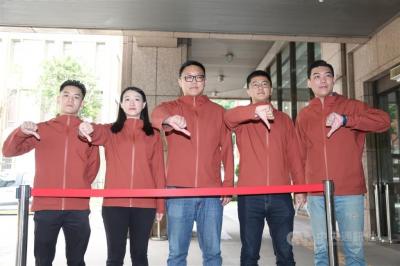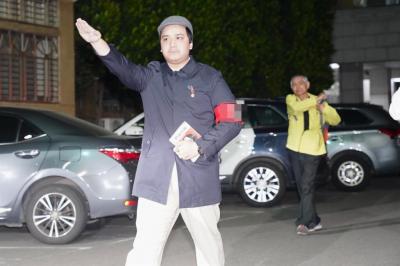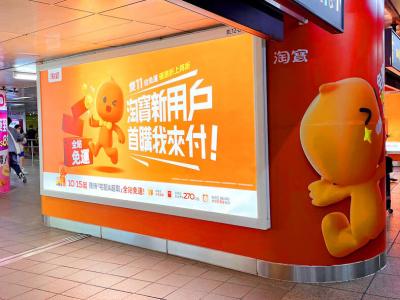Academics and activists yesterday criticized President Ma Ying-jeou’s (馬英九) civil rights and foreign policy at a forum hosted by the Taiwan Forever Association.
Democratic Progressive Party (DPP) legislator-elect Wellington Koo (顧立雄) said that while he had backed the passage of the Police Power Exercise Act (警察職權行使法) — which requires police to use force proportionally and reveal their identities, the act was promulgated before the Sunflower movement’s 2014 occupation of the Executive Yuan’s Main Chamber and people never thought that the “the police would actually beat people.”
Ascertaining who was responsible for what happened is an important part of realizing transitional justice, he said.
Taiwan Forever Association secretary-general Kao Yung-cheng (高涌誠) said he has been kept busy during the eight years of Ma’s administration.
While Ma pushed for legislation giving both the UN’s International Covenant on Civil and Political Rights and International Covenant on Economic, Social and Cultural Rights the force of domestic law, his respect for human rights could only be called “counterfeit” because of the numerous human rights violation cases that occurred under his watch, Kao said.
He dismissed the government’s claim that it was unable to identify the police officers responsible for hitting protesters, stating that police have a face recognition system for which the Ministry of Science and Technology has also contributed funds.
While legislation requires police officers to wear identification stating their names and positions, they often wear raincoats while on duty to avoid recognition, he said.
In related news, Academia Sinica research fellow Wu Jieh-min (吳介民) said that Beijing’s “united front” strategy is complicated and is now focused on enforcing the “suzerainty” of Taiwan. If Taiwan accepts the so-called “1992 consensus,” it would be difficult to turn back because its essence is that both sides of the Taiwan Strait belong to “one China,” he said, adding that the Chinese Nationalist Party (KMT) and Ma no longer refer to the “different interpretations” aspect of the formula as evidenced by Ma’s remarks during his visit to Itu Aba Island (Taiping Island, 太平島) on Thursday.
The “1992 consensus” refers to a supposed understanding reached during cross-strait talks in 1992 that Taiwan and China acknowledge that there is “one China,” with each side having its own interpretation of what “China” means. Former KMT lawmaker Su Chi (蘇起) in 2006 said that he had made up the term in 2000, when he was head of the Mainland Affairs Council, before the KMT handed power to the DPP.
It is fortunate the Sunflower movement happened because it interfered with Beijing’s “united front” strategy, leading it to begin talking about the “1992 consensus” after the KMT’s defeat in the 2013 local elections, Wu said.
Previously, Beijing had only referred to the “one country, two systems” formula he said, adding that last year’s meeting between Ma and Chinese President Xi Jinping (習近平) was an effort at “precautionary damage control” by China ahead of Taiwanese national elections.

Taiwan is stepping up plans to create self-sufficient supply chains for combat drones and increase foreign orders from the US to counter China’s numerical superiority, a defense official said on Saturday. Commenting on condition of anonymity, the official said the nation’s armed forces are in agreement with US Admiral Samuel Paparo’s assessment that Taiwan’s military must be prepared to turn the nation’s waters into a “hellscape” for the Chinese People’s Liberation Army (PLA). Paparo, the commander of the US Indo-Pacific Command, reiterated the concept during a Congressional hearing in Washington on Wednesday. He first coined the term in a security conference last

Prosecutors today declined to say who was questioned regarding alleged forgery on petitions to recall Democratic Progressive Party (DPP) legislators, after Chinese-language media earlier reported that members of the Chinese Nationalist Party (KMT) Youth League were brought in for questioning. The Ministry of Justice Investigation Bureau confirmed that two people had been questioned, but did not disclose any further information about the ongoing investigation. KMT Youth League members Lee Hsiao-liang (李孝亮) and Liu Szu-yin (劉思吟) — who are leading the effort to recall DPP caucus chief executive Rosalia Wu (吳思瑤) and Legislator Wu Pei-yi (吳沛憶) — both posted on Facebook saying: “I

Sung Chien-liang (宋建樑), who led efforts to recall Democratic Progressive Party (DPP) Legislator Lee Kun-cheng (李坤城), was released on bail of NT$80,000 today amid outcry over his decision to wear a Nazi armband to questioning the night before. Sung arrived at the New Taipei District Prosecutors’ Office for questioning in a recall petition forgery case last night wearing a red armband bearing a swastika, carrying a copy of Adolf Hitler’s Mein Kampf and giving a Nazi salute. Sung left the building at 1:15am without the armband and covering the book with his coat. Lee said today that this is a serious

The Ministry of Economic Affairs has fined Taobao NT$1.2 million (US$36,912) for advertisements that exceed its approved business scope, requiring the Chinese e-commerce platform to make corrections in the first half of this year or its license may be revoked. Lawmakers have called for stricter enforcement of Chinese e-commerce platforms and measures to prevent China from laundering its goods through Taiwan in response to US President Donald Trump’s heavy tariffs on China. The Legislative Yuan’s Finance Committee met today to discuss policies to prevent China from dumping goods in Taiwan, inviting government agencies to report. Democratic Progressive Party Legislator Kuo Kuo-wen (郭國文) said